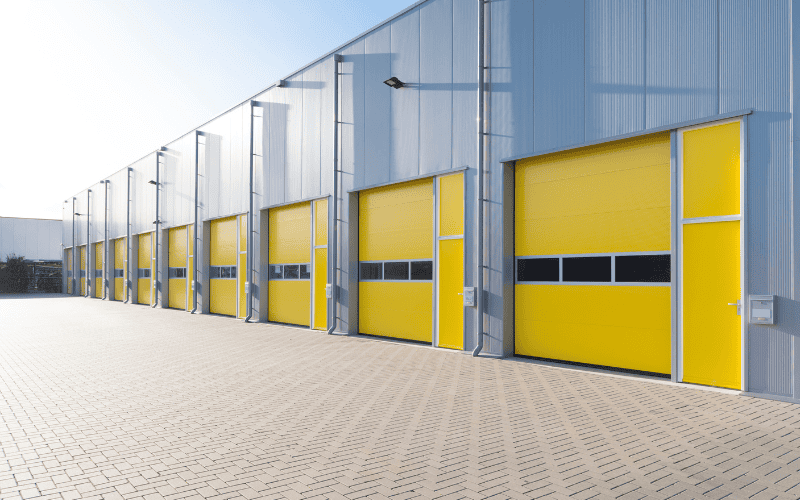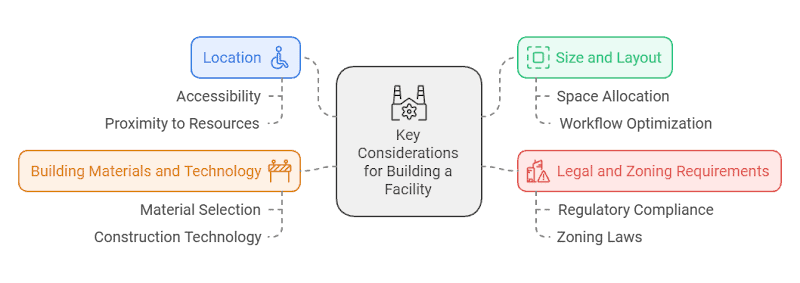Self-storage facilities are becoming increasingly popular, with more businesses and individuals investing in them for extra space and convenience. Whether for storing inventory or personal belongings, the demand is growing.
This guide covers the key steps to build a successful self-storage facility, guiding you from planning through to construction. Whether you’re a first-time investor or seeking new opportunities, this guide offers valuable insights to help you establish a thriving self-storage business.

What is a Self-Storage Facility?
A self-storage facility provides safe, leased spaces for individuals and businesses to store personal or commercial belongings. It provides flexible storage solutions for decluttering, moving, or inventory management. Typically built with steel frames, concrete or steel panels, newly modified shipping containers, reinforced doors, and metal roofing, these facilities combine durability with low overhead costs, making them a valuable investment.
Benefits of Self-Storage Facilities
Self-storage facilities have become a popular and profitable investment, offering a range of benefits to both operators and tenants. These facilities provide versatile, secure storage solutions, whether built using prefabricated steel, shipping containers, or traditional materials like brick and concrete.
Cost Efficiency
Self-storage facilities, especially our built with prefabricated steel structures, are more affordable to construct and maintain compared to traditional brick or concrete buildings. Steel construction reduces labor and material costs, saving up to 30% in initial expenses.
Speed of Construction
Prefabricated steel buildings can be assembled swiftly, cutting construction time by 40-50% compared to brick or concrete options. This allows owners to start generating income sooner.
Durability and Maintenance
Steel structures provide superior resistance to weather, pests, and corrosion, ensuring long-term durability and minimal maintenance. They require less maintenance, making them more cost-effective over the long term.
Flexibility for Tenants
Self-storage facilities provide businesses and individuals with flexible storage options. Customers can rent units of varying sizes, with no long-term commitments, which attracts a broader range of clients.
Security
Prefabricated steel buildings can be equipped with advanced security systems, such as surveillance cameras, gated access, and individual unit alarms, offering high levels of protection for stored items.
Commercial Value
Self-storage facilities have a high return on investment (ROI), with industry reports showing an average ROI of 20-25% for self-storage properties, outperforming other real estate investments.
Space Optimization
Steel buildings allow for taller ceilings and more flexible layouts, maximizing usable space and increasing the number of rentable units compared to traditional brick or concrete designs.
Container-Based Storage Benefits
Shipping containers offer a fast, flexible solution for building storage units. They arrive ready to use, require minimal modification, and can be easily added or relocated as your needs grow. Their strong steel structure also provides great weather protection and security, making them a smart choice for cost-conscious projects.
How to Build a Self-Storage Facility?
Developing a self-storage facility can be a profitable investment, but it demands thorough planning and precise execution. Selecting the right location and materials are among the key factors that require careful attention for achieving success. This guide outlines the key steps to help you successfully plan, build, and operate a self-storage facility.

1. Choose the Right Location
The success of your self-storage facility is largely determined by its location. Choose a site with high visibility and convenient access, preferably near bustling residential or commercial zones. According to industry data, 70% of customers prefer storage units within a 5-mile radius of their home or business.
Additionally, consider locations near universities, military bases, or large office parks, as these areas often have a steady demand for storage. Proximity to major highways, transit hubs, and densely populated neighborhoods can also boost your facility’s visibility and accessibility. Areas with limited competition or a growing population are ideal for long-term growth.
2. Determine the Size and Layout
The size and layout of your facility should be tailored to local demand. Offer a variety of unit sizes, from small lockers to larger spaces for vehicles or bulky equipment. Studies show that facilities with diverse unit types have 30% higher occupancy rates than those with limited options.
3. Meet Legal and Zoning Requirements
Make sure your site meets local zoning laws, building codes, and safety standards, including restrictions on height, size, and allowable structures. Non-compliance can lead to delays and higher costs. We will assist you in navigating and complying with all relevant legal and zoning requirements, ensuring a smooth and efficient process.
4. Consider Building Materials and Technology
Using prefabricated steel structures for your facility can reduce construction time by 40–50% and lower costs by up to 30%. Modular storage units offer flexibility and scalability, allowing you to expand as demand grows. Steel also guarantees exceptional durability and requires minimal upkeep. Shipping containers can also be used as modular units, offering a ready-made steel shell that’s easy to install, cost-effective, and ideal for phased or compact builds.
Choose Us for Building a Successful Self-Storage Facility
Building a self-storage facility is a smart and profitable investment. By understanding the fundamentals of self-storage, carefully planning your facility, and following a well-executed construction process, you can create a successful business that meets the growing needs of both individuals and businesses. Prioritize tenant needs and security to build trust and ensure the long-term success of your self-storage business.
We have been exporting prefabricated steel structures for over 15+ years. We partner with suppliers who follow MBMA, AISC, and AISI standards to provide top-quality, custom materials tailored to your specific needs and local building codes. Discover how our self-storage buildings can bring your project to life.
Questions You May Still be Concerned About
1. How to Set Up a Self-Storage Company?
To set up a self-storage company, conduct market research, secure funding, choose a prime location, and ensure compliance with local regulations. A solid business plan and strategic marketing will also be key to attracting tenants.
2. What Are the Requirements of an Ideal Storage Facility?
An ideal storage facility must offer security, accessibility, a variety of unit sizes, and climate control options for sensitive items. It should be easily accessible and well-maintained to meet customer needs.
3. What Is the Average Profit Margin for a Storage Facility?
The average profit margin for a self-storage facility is typically between 30-40%, influenced by factors like location, occupancy rates, and operational efficiency. A well-managed facility can achieve even higher margins.
4. Where Is the Best Place to Build a Storage Facility?
The best location for a storage facility is near residential areas, business hubs, or high-traffic zones, where there is a steady demand for extra storage. Being close to major roads and transportation hubs is just as crucial.
5. How Can I Increase My Storage Area?
To increase storage space, consider expanding vertically with multi-story buildings or adding modular units. Efficient space planning and maximizing unused areas can also help optimize storage capacity.
6. What Is Larger Than a Steel Structure Self-Storage Facility?
Larger than a steel structure self-storage facility is a Prefabricated warehouse building. These warehouses offer significantly more space, designed for commercial or industrial storage, distribution, or manufacturing. Unlike self-storage, they are usually tailored for bulk inventory or heavy-duty storage needs.

